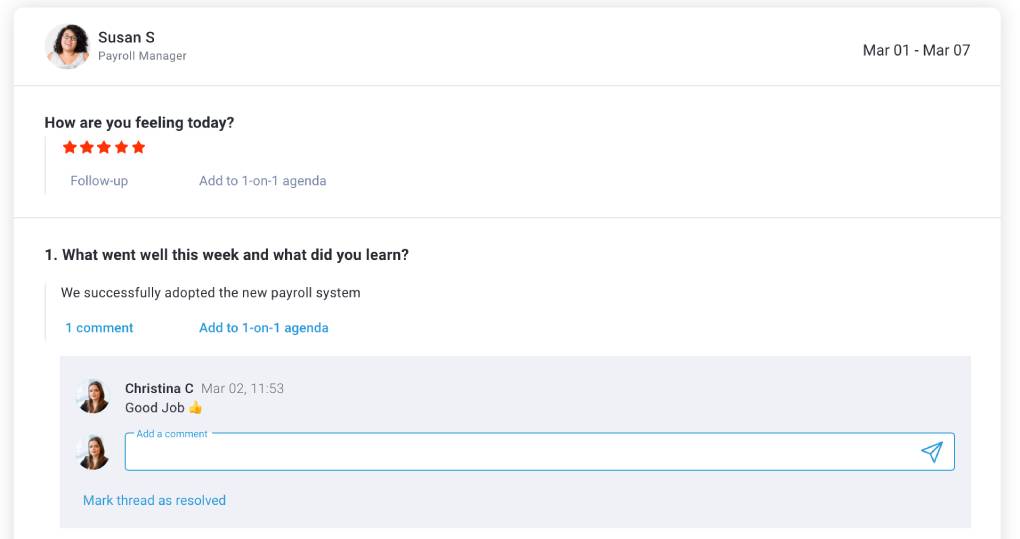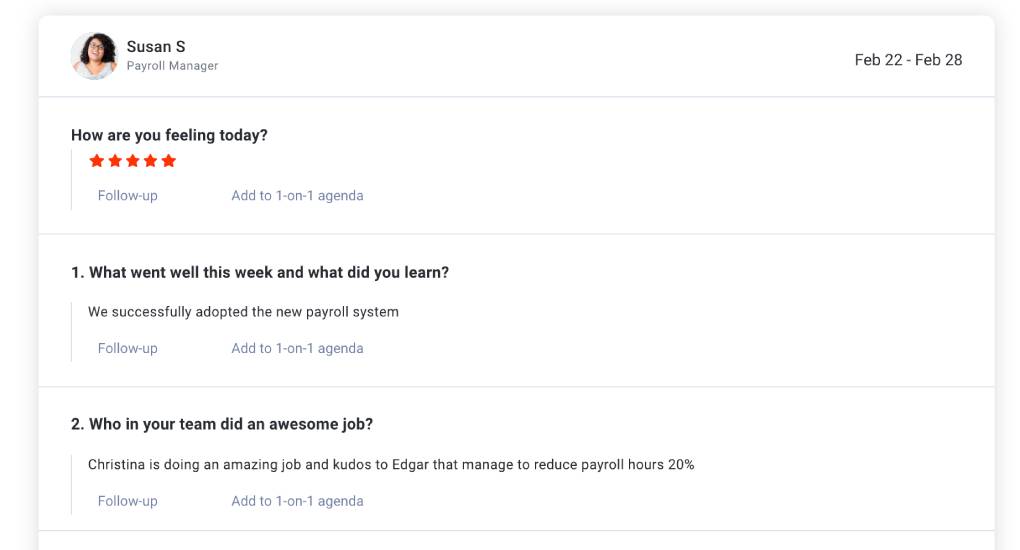#Employee Engagement #Performance Management #Management Tips
Michelle Sheridan
As a versatile project manager and HR content writer, Michelle develops successful organizational development programs and shares insights with the world at large to facilitate healthy workplace cultures of diversity, inclusivity, and advancement. She has written about manager development, remote work, project & time management, employee well-being, and other relevant topics to help people excel in the modern workplace.
Pub: March 3 2021
Upd: November 14 2022
We sometimes think that providing positive feedback is as simple as saying “Good job” to our colleague as we exit a meeting. However, by doing that, we miss an opportunity to really dive into what our colleagues are doing that makes their work valuable. Below are some tips on how to improve your communication skills to make your positive feedback count.
Table of contents:
- Why Giving Positive Feedback is Important
- Tips to Provide Feedback that Counts
- Positive Feedback Examples
- Things to Avoid when You Give Positive Feedback
- How Hirebook's Check-Ins Feature Helps You Provide Bilateral Positive Feedback
Why Giving Positive Feedback is Important:
You’ll often hear people fret about how to give negative feedback to a co-worker or direct report. But how often do you hear the question, “How should I deliver this positive feedback?”
Structured positive feedback allows a person to understand the impact of their behavior, and increases the likelihood of them repeating those same successful behaviors. It’s beneficial for company culture and it promotes team morale while increasing productivity and engagement, all while helping people understand and develop their skill set. This has a net positive effect on your team which in turn drives more impactful results.

Giving positive feedback is an essential part of any organization's culture. Both manager-driven and peer-to-peer feedback facilitate a growth mindset by identifying successful efforts and actions rather than innate abilities.
Tips to Provide Feedback that Counts:
Next time your team members or colleagues knock it out of the park, consider these tips when telling them how well they did:
1. Be Sincere. Don’t just give praise for the sake of giving praise. For positive feedback to be most effective, it should be when an employee truly deserves it. Your message will be much stronger if it comes from a place of authenticity.
2. Be Specific. Your positive feedback should be as targeted and specific as possible. Let your colleague know exactly what it is that you are praising - this allows them to better understand their skillset and continue to improve.

3. Be Timely. Provide your feedback as soon as possible, rather than waiting for a check-in, performance review, or performance meeting. You can praise your colleagues on the spot or even on the team chat. Doing so allows your colleague to feel seen in their efforts and again reinforces those successful behaviors.
4. Highlight Effort and Behavior. Focusing on effort and behavior, rather than inherent skill sets, encourages the development of a growth mindset. This method leads to greater engagement and a higher probability of taking on new challenges.
5. Tie it to the Bigger Picture. Tie your feedback to the larger issue at hand. Actions don’t exist in a vacuum - when a colleague sees how they are contributing to their team members or company goal, they become more motivated to continue the type of work that leads to successful results.
Positive Feedback Examples:
Here are some examples of positive feedback for you to consider when giving constructive feedback, and how you would frame it:
1. When someone meets or exceeds goals:
"Jose, congratulations on exceeding your sales goal this quarter! Your dedication and tenacity to closing those last ten sales has helped us reach our team goal of generating $1M in revenue, and will go a long way towards helping us reach our yearly targets."
2. When someone helps a peer or customer:
“Lisa, thank you for taking the time to walk Mikaela through her questions this morning. She’s still learning the software, but I know you’ve given her a great confidence boost by teaching her how to use it more effectively. By helping her get up to speed, you’re ensuring that we can work together more efficiently as a team.”
3. When a peer finishes a difficult project:
“Great job on this project, Elena. I know this wasn’t easy for you with all of the hiccups we experienced along the way - but your effort and dedication allowed us to finish on deadline. We all appreciate your hard work on this.”
4. When a colleague takes initiative:
“You came up with some exciting ideas during Monday’s executive meeting, Robert. Great initiative - I particularly liked your recommendation on how to better share those survey results with the company at large. I think this will be useful in moving us towards a more transparent culture.”
5. When a co-worker needs a confidence boost:
“Just wanted to let you know that I’ve appreciated your effort in drafting this process documentation, Rachel. I know it might seem like a tedious task, but your work is essential to making sure that we can move forward and implement this new software.”
6. When praising performance while giving advice:
“You handled that client meeting really well, John! They were frustrated at first, but they seemed happier with your suggestions by the end. In your next meeting, you might want to consider doing this…”
7. When a colleague models good behavior:
“You demonstrated true leadership skills in yesterday’s team meeting, Lee. I know that the discussion became a little heated, but you handled everyone’s questions calmly and accurately. Thanks to that, we were able to reach a consensus and now we can move forward on the project instead of delaying another week. I look forward to seeing how you further develop these skills!”
8. When a co-worker takes on new responsibilities/role:
“We made the right decision when we promoted you to the PM role, Jazmine. Your productivity has been off the charts lately, and the team is responding really well to your leadership skills. Keep up the good work - it’s paying off!”
9. When someone shows great development:
“I’ve noticed you’ve come a long way since you started working here, Ryan. I’m particularly impressed with your ability to solve problems under pressure and your attention to detail.”
10. When someone strives to learn:
“Paula, I am impressed with your thirst for knowledge. I know you’re going to grow fast in our company and develop a great career if you keep it up!”
Things to Avoid when You Give Positive Feedback to Your Team Members
Here are some things you might want to avoid when working positive feedback into your management toolkit:
1. Overpraising. Work positive feedback into your repertoire, instead of going from 0-100 all at once. You might think that effusive praise is more beneficial for colleagues and team members, but it runs the risk of sounding empty and not providing any constructive value. Be targeted and direct in your employee feedback.
2. Praise for Mundane Tasks. As with overpraising, this can sound empty and doesn’t provide real value. Save the constructive feedback for the real wins!

3. Upwards Feedback. Be tactful when approaching your boss or someone more senior than you. This is another opportunity to be as specific as possible while tying the positive feedback to the bigger picture.
How Hirebook’s Check-Ins feature Helps you Provide a Bilateral Positive Feedback
Checking in with your employees develops a healthier and more positive relationship with them. In order to increase employee engagement, it is important that your employees feel heard and that they can count on you. By giving them a space where they can share how they feel and the positive and negative aspects of their week/fortnight/month, you won’t only know how they’re performing, but you’ll also be able to learn more about their strengths and areas of improvement, and they’ll know that your interest in their wellbeing is genuine.
In the same way, allowing your employees to provide you with feedback and give you their opinion about their peers’ performance opens a bilateral communication channel and generates admiration towards the rest of the team, allowing you as the manager to see aspects of everybody else’s work that maybe they forgot to share or were too shy to “brag about”. Asking your employees to share their vision about the positive performance of their team drives everyone to admire their peers and generates an urge to learn from others, which in the end results in better professional development and personal enrichment.
We’re finally understanding that employee feedback doesn’t always mean pointing out the negatives. Constructive feedback can be both positive and negative, but always focused on getting the best out of our colleagues.
We hope these positive feedback examples work out for you and provide a clear picture of the benefits of giving specific employee feedback. Everyone needs a little boost from time to time, right?
Positive feedback is a powerful tool to bring out your team’s best performance. By cultivating an environment that encourages praise, organizations can proactively address engagement issues and increase retention. A company culture based on collaboration and inclusiveness goes a long way towards improving engagement and productivity while increasing the company’s bottom line. Try these tips out next time you want to offer praise and give positive feedback, and let us know how it goes!
Hirebook is a performance management tool that helps remote teams link their day-to-day actions to strategic organizational outcomes. Try Hirebook for free today to utilize check-ins, 1-on-1s, and OKRs to help your team achieve the next level of success.
Photo credit - PeopleImages/Getty Images
- Relevant
- Recent
- Topics
- Archive
- April 2023 (1)
- March 2023 (1)
- June 2022 (1)
- May 2022 (3)
- April 2022 (3)
- March 2022 (5)
- February 2022 (2)
- January 2022 (3)
- December 2021 (3)
- November 2021 (4)
- October 2021 (5)
- September 2021 (8)
- August 2021 (7)
- July 2021 (2)
- June 2021 (3)
- May 2021 (5)
- April 2021 (8)
- March 2021 (4)
- February 2021 (3)
- January 2021 (3)
- December 2020 (6)
- November 2020 (9)
- October 2020 (1)
- September 2020 (5)
- August 2020 (4)
- July 2020 (1)
Discover More Hirebook Posts










